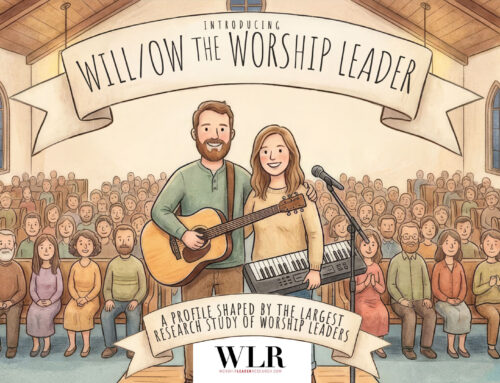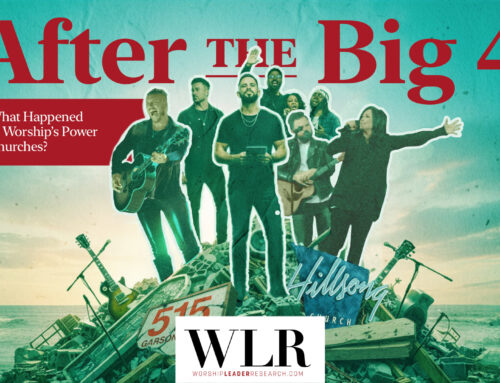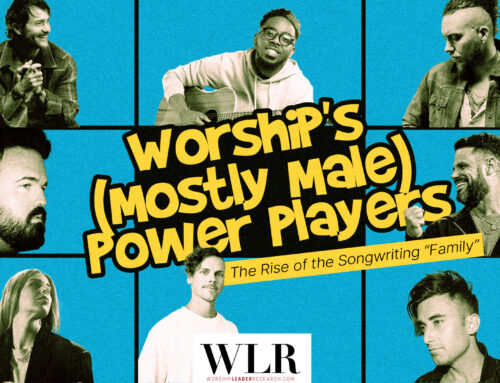Dear Worship Leader Research,
Hasn’t it always been the case that a small number of churches have dominated the contemporary worship industry?
Sincerely,
Concerned Worship Leader
We’ve been getting this question a lot lately. It’s a good question and it does appear that way from a 30,000-foot view of history. But the question possesses (at least) two assumptions that make answering the question a bit tricky. First, it assumes there has always been a centralized contemporary praise and worship music industry in which churches/labels participated and were connected. Second, the question assumes the prominent churches in this history had tight control of the music groups or labels associated with them.
As we explore, here, each of the historic churches in the worship music world were connected to music recording and publishing in ways that were distinct to each church-label connection. A dive into history shows that a centralized industry for producing and supplying churches, with a core repertory of songs, emerged later than is often assumed (i.e. in the early 1990s, not the early 1970s). Before the 1990s, dissemination of worship songs was largely ad hoc as songs (and recordings) traveled more easily within these churches’ respective networks than beyond them. More so, the churches producing these songs and recordings were most prominent as churches and not as music industry labels or partners.
In each section below we’ll try to make some relevant connections between how these historic churches operated and how our “Big 4” operate today.
Historic Examples of Church-Industry Connections in Worship Music
In the history of worship music, we see important networks of churches that had a greater influence than others. We might think of Calvary Chapel Costa Mesa and the Calvary Chapel network of churches that were affiliated with and adjacent to Maranatha! Music (think Jesus People). Somewhat lesser known is the affiliation between Gulf Coast Covenant Church/Covenant Church of Mobile (Alabama) and Integrity Music. This Church was affiliated, for some time, with the Shepherding Movement and its pastors were prominent in the Pentecostal-Charismatic Renewal movement (think coat-and-tie Pentecostals, not Jesus People). We might also think of Anaheim Vineyard Church, the Vineyard network of churches and the Mercy Music label. Each of these churches created and recorded worship music. But they did so primarily for their own networks and there was little overlap or exchange between them (unlike the cross pollination visible today). Each church-music connection was established in the 1970s and 1980s but a centralized and consolidated Christian worship music industry didn’t exist until the 1990s.
But, let’s not get ahead of ourselves. This early era of the church-music recording interface was distinct and is worth exploring at greater length as we think about how today’s situation is both similar and different. Let’s take a closer look at three of the major, early contributors and the specific connections between their originating churches and the music arms that would gain notoriety through them: Calvary Chapel/Maranatha! Music, Gulf Coast Covenant/Integrity Music, and Vineyard/Mercy Music.
What early church-music recording interfacing looked like
Calvary Chapel/Maranatha! Music
Early records released by Maranatha! Music were seen as an outreach and musical extension uniquely characterizing this church community. Initially, Calvary Chapel Costa Mesa’s pastor Chuck Smith occupied the helm of both the church and the label. More broadly than the church, though, the label was an early host to more than a dozen different musical acts (including non-worship groups) emerging out of the Jesus People Movement in Southern California – most of which were not formally affiliated with Calvary Chapel—Children of the Day is a notable exception. By the 1980s, Maranatha! had moved over to exclusively praise music with the Praise Album series by “The Maranatha! Singers,” an in-house group consisting of various configurations of singers. Simple praise choruses like “Seek Ye First” by Karen Lafferty or “Father, I Adore You” by Terry Coelho appeared on these early albums, with Lafferty and Coelho as member/performers in The Maranatha! Singers. The company was later sold to Chuck Fromm (who had been managing it since the mid-1970s) and others as an independent business. Though the Maranatha! Singers group appeared akin to Bethel’s worship collective model, today, the Maranatha! Singers were not —unlike Bethel — formally affiliated with the Calvary Chapel church or signed to a Calvary Chapel record label, like the Bethel Music label. And, unlike Hillsong, the singers in the group were not “homegrown” talent from within the church network.
Covenant Church / Integrity Music
Integrity Hosanna! Music (later Integrity Music) began as a direct-to-consumer subscription tape series under the Pentecostal-charismatic-affiliated, New Wine Magazine, in July 1985. New Wine’s leadership consisted of ordained elders from Gulf Coast Covenant Church/Covenant Church of Mobile, but operated as its own company, separate from the church. Both under New Wine and when they, officially, became independent under Mike Coleman and Ed Lindquist in January 1987, Integrity’s Hosanna! Music did not have its own artist roster. Instead, Integrity collected songs (sometimes with anonymous writers) that were already in circulation within Pentecostal and charismatic networks of churches. They compiled and recorded these albums using local church worship leaders who were also known within those ecclesial networks. Later, in 1988, Marty Nystrom (author of “As The Deer”) joined Integrity as the first artist and repertoire (A&R) director and Don Moen (popularizer of “Give Thanks”) as creative director. These hires came after the connection to the magazine and church were dissolved and signaled a shift in the business model from collecting songs to cultivating worship leaders as artist/songwriters.
How is this distinct from our “Big 4” churches? Well, we might compare Integrity Music’s early approach to Passion/Sixsteprecords. Unlike Integrity, early Passion/Sixstepsrecords was intimately connected with a large annual event: the Passion Conference. These Passion Conferences, in the early 2000s, certainly helped popularize newer artists like Chris Tomlin and David Crowder. In that way, both early Integrity and early Passion helped promote lesser known artists (though, today, the Passion Conference tends to highlight artists who are already well known, including Elevation and Hillsong artists). As far as recordings go, Passion albums bring together a variety of artists to create an album affiliated with the Passion conference event while early Integrity albums brought together (sometimes anonymous) songs to create an album.
Vineyard Church/Mercy Music
The Vineyard Fellowship of Churches is perhaps an outlier as it partially prefigures what we see, today. The Vineyard Fellowship of Churches was initially founded by Kenn Gulliksen in 1977 before John Wimber became the face and sound of the movement. Wimber was the pastor of Calvary Chapel Yorba Linda, which transferred into the Vineyard Fellowship in 1982 after severing ties with Calvary Chapel over his emphasis on the work of the Spirit and spiritual gifts (the church was later known as Anaheim Vineyard). Wimber quickly grew to national leadership in the broader Fellowship of Churches (which numbered 200 by 1986). Wimber brought his personal experience in the music industry as a performer and recording artist to launch the Mercy Records label in the early-1980s. Vineyard/Mercy’s first album All the Earth Shall Worship: Worship Songs of the Vineyard was published in 1982 with Wimber as executive producer, songwriter, arranger, and keyboard player. The album highlights a core set of worship music leaders affiliated with the church network, especially at Wimber’s church. Early leaders/songwriters included Carl Tuttle (“Hosanna”), Eddie Espinosa (“Change My Heart Oh God”), and Pastor John Wimber (“Spirit Song”). So to say, Wimber was both a pastor of what became the flagship Vineyard church, the larger Vineyard network, and the leader of the early Mercy music label. To be fair, describing Mercy as a label is perhaps a generous designation as it did not distribute much more than Vineyard-specific recordings.
Thinking about some comparisons with our “Big 4”: Elevation pastor Steven Furtick is also listed as a co-writer on most Elevation songs, though Furtick does not perform with the musical group. For Bethel and Hillsong, familial relationships—rather than direct leadership—have marked a close connection between church and music arm; Brian Johnson (son of Bethel Pastor Bill Johnson) and Joel Houston (son of Hillsong Pastor Brian Houston) have played central roles in each church’s musical output. Wimber is distinct with a background in the music industry, head pastor of a network of churches, and as a central performer on Vineyard recordings. Notably, Vineyard/Mercy music was much less prolific than today’s churches.
CCLI
From the 1960s through the 1980s, dissemination was ad hoc and each community’s songs traveled more easily within their affiliated networks of churches, rather than beyond them. The emergence of Christian Copyright Licensing International (CCLI) and its growth in prominence in the late 1980s and early 1990s was a critical development that began the process of centralizing the church-facing worship music industry in the way we know it today (founded as CCLI in late 1988). Early on, CCLI, too, had a church connection. CCLI was, initially, a product called StarPraise Ministries, launched at Bible Temple in Portland, Oregon around 1985 (under pastor Dick Iverson). CCLI’s early architects, including Howard Rachinski, Shari Iverson, and Tim Smith, were in music ministry leadership roles at this Oregon church. Bible Temple was an important worship music node in the Latter Rain Pentecostal network of churches out of which the Praise and Worship tradition initially grew. Indeed, each of the above-mentioned churches’ music embodied a distinct worship culture and theology of the network from which it originated (something largely indistinguishable to today’s casual listener).
With the growing use of CCLI licensing and publication of popularity charts, the visibility of various individual artists and church groups (and worship theology) substantially increased and bridged many church traditions. Before that point, smaller worship-related events like conferences and revivals (often run by individual churches or networks) were the primary sites for disseminating worship songs. Some larger-scale ones, like those affiliated with the Charismatic Renewal Movement and parachurch ministry organizations, also played a role. But CCLI won out among a variety of other services that were attempting to leap the legal hurdle of church copyright permissions. In doing so, they made access to these songs less provincial and more widely available. Ultimately, CCLI helped to centralize the church/publishing interface within the contemporary worship context. The top song lists helped reinforce a sense of an industry-standard catalog of songs beyond the discrete church networks in which these songs had previously and somewhat independently circulated.
It is important to remember that it wasn’t until the mid-1990s that people could show up at a local Christian bookstore and simply browse a variety of worship tapes/CDs from a variety of sources. Today, worship conferences still play an important role—but with an industrialized twist. For example, the WorshipTogether Conference is a primary site for sharing songs and is owned by Capitol CMG, the group who stands to gain significantly from popularizing songs from their own roster and catalog. Admittedly, church leaders encounter worship songs through a wide variety of other means as well, including lists of popular songs published by CCLI and PraiseCharts, curated playlists on streaming services, prominent worship leader’s public platforms—a topic we’ll be engaging in forthcoming releases of our research.
Looking ahead from the 1990s, the process of consolidating and centralizing the worship music industry was drastically accelerated in the early 2000s as major music companies like Sony, Warner, and Universal created or acquired Christian music divisions and many other smaller labels. For example, Sparrow Records —once the label of major Christian artists like Keith Green and 2nd Chapter of Acts—was acquired by EMI in 1992. In 2012, EMI was acquired by Universal Music Group and reorganized under Universal’s subsidiary, Capitol Records, as Capitol Christian Music Group.
Today, Passion’s record label, Sixsteps, is a part of Capitol CMG (CCMG), which belongs to the parent company Universal. CCMG also handles U.S. distribution for Hillsong. Elevation Worship signed to Essential Records in 2011, whose parent company is Sony. Five years later, in 2016, Elevation started their own record label and have operated independently since that time. Similarly, Bethel Music has operated as an independent music label since 2010.
TL;DR
To summarize, then, yes, there have long been some key churches in the creation, recording, and dissemination of songs for contemporary praise and worship. Unlike today, however, those key churches, as churches, were most prominent within the ecclesial traditions and church networks from which they originally emerged. Each church’s connection to its affiliated music label was distinct and the relationship seems to have grown more distant over time. Though there are a handful of similarities between then and now (as noted above), there did not exist a centralized “worship music industry” until at least the early 1990s when CCLI established itself as the central manager of church copyright licensing, publisher of top song lists, and, later, popular resource for worship music resources.










